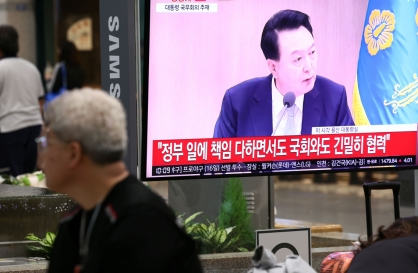[Editorial] NK drone infiltration
South Korea failed to track and bring down UAVs, revealing holes in defense capability
By Korea HeraldPublished : Dec. 29, 2022 - 05:30
The latest infiltration of five North Korean drones into South Korean airspace on Monday sparked heated criticism on the South’s military preparedness and raised many bewildering questions about whether there is an effective way to track and shoot down small uncrewed aerial vehicles at all.
On Tuesday, the South Korean military apologized for its apparent failure to properly respond to the North Korean drones that flew over densely populated Seoul and residential areas along the western inter-Korean border.
The South Korean military scrambled fighter jets and attack helicopters in response to the drone infiltration, but the result was utterly disappointing. One UAV was believed to have returned to North Korea, while the whereabouts of the other four remain uncertain.
At a time when drones are increasingly deployed for reconnaissance and other offensive purposes in military conflicts across the world, the fact that North Korean UAVs flew over Seoul and Incheon airspace for up to five hours before disappearing without any effective counterattack lays bare the lack of preparedness on the part of the South Korean military.
Amid a flurry of critical responses, government and military officials, as well as experts, are putting out explanations about what went wrong Monday and why the South Korean military is not ready to track and bring down small reconnaissance drones from North Korea.
President Yoon Suk-yeol sharply criticized Defense Minister Lee Jong-sup over the military’s failed operation against the North Korean drones Tuesday, asking why there was no proper training despite similar incidents in the past. Yoon also ordered officials to shoot down North Korean drones if necessary and send two to three drones across the border if the North sends one.
It was 2014 when the remains of North Korean drones were discovered near the inter-Korean border, and experts warned that the South Korean military should step up countermeasures given that drones had filmed the South Korean presidential office and military facilities.
Media outlets reported that one North Korean drone might have taken photos of parts of Seoul including the area close to the presidential office in Yongsan. The military denied such possibility, but it cannot be completely ruled out, given that such incidents had already taken place in the past. This raises inevitable questions about what would happen if future North Korean drones equipped with small attack weapons make it into Seoul airspace again.
As Yoon pointed out, the military has been wasting time and resources in building up an effective defense line including laser detection and jammer systems to detect and shoot down North Korean drones. The South Korean military also failed to promptly coordinate action among military units against the drone infiltration.
It is understandable that tracking and shooting down a small drone is extremely difficult. After all, the firing of weapons against drones could result in tremendous collateral damage to residential areas.
But the military has no excuse for belatedly issuing its military readiness alert at its highest level of “Jindogae 1,” indicating immediate danger or imminent attack, at around 4 p.m. Monday -- by which time it was effectively impossible to track the whereabouts of the North Korean drones.
Until the alert was issued, low-flying military aircraft rattled residents, while travelers had to face flight delays without knowing the specific cause.
The South Korean military is also under fire for a series of aircraft crashes and missing missiles due to its flawed management of military assets and training system, even though the annual defense budget had been set at over 50 trillion won ($39 billion) in recent years. A striking example is none other than the KA-1 light attack aircraft that crashed shortly after taking off from its air base to respond to the North Korean drones on Monday.
On Wednesday, President Yoon stressed that any North Korean provocation should be met with a resolute in-kind response, a day after he pledged to increase the budget for anti-drone operations and to speed up the establishment of a drone unit. Also on Wednesday, the military unveiled a new plan to spend 560 billion won over the next five years to strengthen its anti-drone capability.
The new steps for drone attacks appear necessary to step up military preparedness. Given that the North seeks to catch the South off guard with various tactical moves and new military technologies, the government should check the country’s overall security capability, which is now saddled with flaws and complacency.
-
Articles by Korea Herald






![[From the Scene] Monks, Buddhists hail return of remains of Buddhas](http://res.heraldm.com/phpwas/restmb_idxmake.php?idx=644&simg=/content/image/2024/04/19/20240419050617_0.jpg&u=20240419175937)








![[From the Scene] Monks, Buddhists hail return of remains of Buddhas](http://res.heraldm.com/phpwas/restmb_idxmake.php?idx=652&simg=/content/image/2024/04/19/20240419050617_0.jpg&u=20240419175937)

![[KH Explains] Hyundai's full hybrid edge to pay off amid slow transition to pure EVs](http://res.heraldm.com/phpwas/restmb_idxmake.php?idx=652&simg=/content/image/2024/04/18/20240418050645_0.jpg&u=20240419100350)

![[Today’s K-pop] Illit drops debut single remix](http://res.heraldm.com/phpwas/restmb_idxmake.php?idx=642&simg=/content/image/2024/04/19/20240419050612_0.jpg&u=)